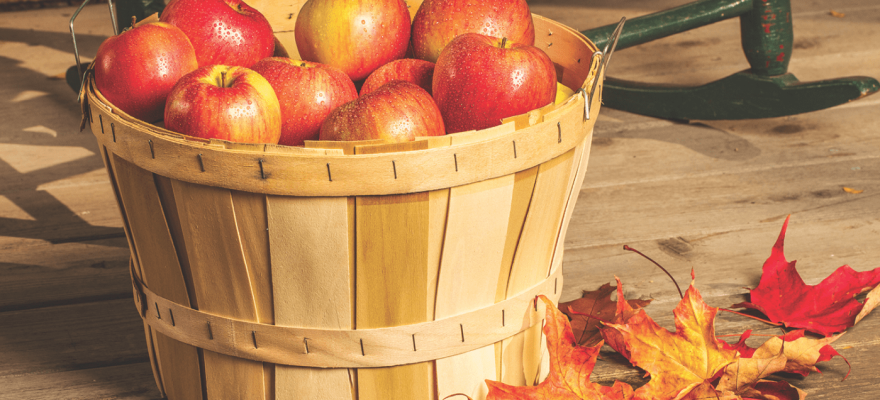
Apples are one of the most widely-grown tree fruits. They can be put to use in all different types of food applications – from desserts to sauces to beverages. As a stand-alone snack, apples are a healthy source of antioxidants and fiber. Apples have many other qualities and an interesting history. Consider these facts about apples.
Apple Fast Facts
- · The term “apple” comes from the Olde English word, “aeppel.”
- · Apples are believed to have originated somewhere between the Caspian and Black Seas, but now they are grown all over the world.
- · The main producers of apples in the United States include the states of Washington, New York, Michigan, Pennsylvania, California, and Virginia.
- · There are thousands of different apple varieties.
- · Apples were taken to North America by European settlers.
- · Honeybees are a popular pollinator of apple trees.
- · Apple seeds contain a small amount of cyanide compound. They’re not harmful if eaten in small quantities.
- · Many apple harvests are still picked by hand.
- · Fifteen types of apples account for 90 percent of total production. Red Delicious, Gala, Golden Delicious, Granny Smith, and Fuji lead the way.
- · A bushel of apples weighs 42 pounds while a peck weighs approximately 10.5 pounds.
- · The crabapple is the only apple native to North America.
- · Apple trees won’t bear their first fruits until they have matured four to five years.
- · The largest apple picked weighed three pounds.
- · The nutritional benefits of apples spurred the saying, “An apple a day keeps the doctor away.”
- · It’s fun to go apple-picking, and many people flock to orchards in September and October to pick their own apples.
Sources: University of Illinois Extension, Eat This!, Love to Know Corp., and Science Kids®.
Pick a Peck of Apples!
According to the Agricultural Marketing Resource Center, the United States produces roughly 9 billion pounds of apples each year, a distant second from China. While the state of Washington is our lead producer, it may be surprising to hear that every state in the U.S. produces apples. The availability of apples is convenient, but with over 7,500 different varieties, it leaves questions as to which apple variety to choose.
Sweet apples include Red Delicious, Golden Delicious, Gala, Fuji, and Honeycrisp. Red Delicious is a popular snacking apple but is not great for baking or freezing.
On the other hand, Golden Delicious, is probably the “Best All Around” apple, perfect for snacking, baking and freezing.
Other all-purpose apples include Granny Smith, Rome Beauty, Fuji and Jonagold. Granny Smith apples are tart and keep their shape when cooked, also making them ideal for pies.
McIntosh, a sweet-tart apple falls to pieces when cooked so is excellent for making applesauce. Winesap apples get their name from their slightly tart, spicy, wine-like flavor making them a top pick for cider.
No matter which apple you choose, allow for about 2 pounds of apples to fill one nine-inch pie. Store them in the refrigerator in the crisper drawer and away from other strong odor foods. Apples release ethylene gas, which can be damaging to lettuce and other produce. Happy apple picking!
By Jenna Smith, an educator with the University of Illinois Extension outreach program.
How to Store Fresh Apples
Apples are available year-round, but many apple lovers insist there’s nothing better than plucking an apple directly off the tree in the fall. Apple orchards and pick-your-own farms are visited each autumn by apple lovers anxious for apples’ tart and juicy taste. Many people pick more apples than they can eat in a few days, so it pays to learn how to store apples properly so none of them go to waste.
Start by picking a variety of apple that won’t go bad too quickly. Apple growers can make suggestions, but Jonathan, Rome, Fuji, and Granny Smith varieties tend to last longer than other varieties. Choose apples that are free of blemishes or soft spots. The adage that “one bad apple can spoil the whole bunch” bears some truth. Apples give off ethylene gas as they decay, and a rotting apple can quickly affect nearby apples, lettuce, or other produce.
A good place to store apples in the short-term is in the refrigerator crisper drawer where it is cool. Do not store them with vegetables, as the apples may cause the veggies to ripen or rot prematurely.
If you plan on long-term storage, a few extra steps are necessary. Apples need to be individually wrapped so they will not come in contact with other apples. Newsprint works great; just be sure to pick the pages that are done in black ink because colored ink may contain heavy metals.
Once wrapped, place each apple in a container padded with more newspaper. Store this container in a cool place, such as a garage, root cellar or screened-in porch. Apples can last a couple of months if stored in this manner. Keep apples away from potatoes, as potatoes can cause the fruit to prematurely decay.
Another way to store apples is to turn them into preserves, or apple sauce. Turning apples into candied or caramel apples also can help them keep longer. Of course, you always can bake apples into a pie as well, then freeze the pie for another day.
CLICK HERE for a list of local apple picking farms!

Read Next | This Is Where You Can Get Amazing Kids’ Birthday Party Ideas






